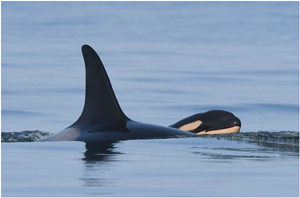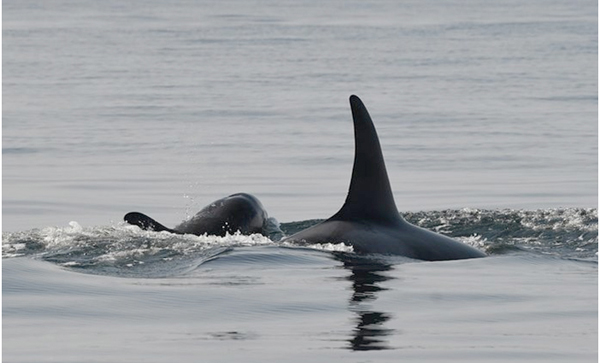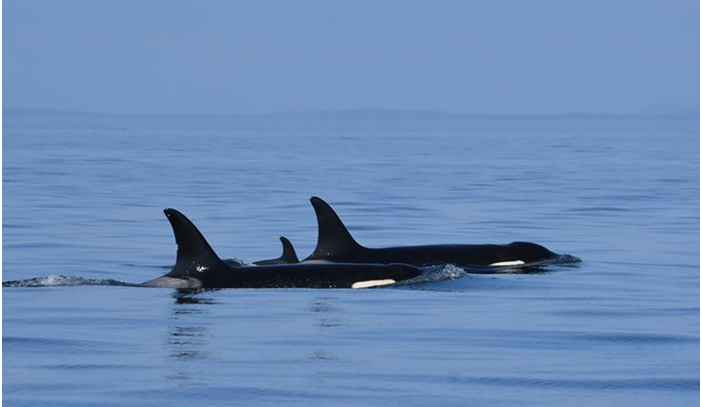
Sunday September 6, 2020 ~ VANCOUVER ISLAND, BC [Updated September 7, 2020] & UPDATE September 23, 2020: “It’s a boy”!
by Mary P Brooke, editor | Island Social Trends
Vancouver Islanders are welcoming the new orca whale calf J57, born to the endangered Southern Resident Killer Whale (SRKW) J-pod. The new calf was first spotted yesterday, Saturday, September 5.
With this new calf in J-pod — now designated as J57, the SRKW population now numbers 73 (building on an estimated J-pod population of 72 at July 1).
The adventure of discovery:
Yesterday J-pod was reported near the ODAS buoy off Dungeness Spit in the eastern Strait of Juan de Fuca in US waters. Another large group of the endangered Southern Resident Killer Whales (SRKW) was a few miles away near Race Rocks in Canadian waters swimming toward them.
It was hoped by Center for Whale Research personnel could encounter a ‘superpod’ aggregation of J, K, and L-pod whales in the inshore waters of the Salish Sea for the first time this year.
They launched three boats with researchers (two from San Juan Island and one from Victoria) to photo-identify every individual for a population census.
Profile of the pods:
Usually The Center for Whale Research has an accurate census of the Pacific Northwest ‘residents’ by July 1 each year. But this year, the salmon spawning migrations to the Fraser River have been so poor that the whales that must eat these salmon to survive have rarely come into what used to be their core summer habitat, said the Center for Whale Research in a news release today.
A few small groups of these critically endangered whales ventured inshore in July, and J-pod in its entirety showed up at San Juan Island on September 1. J-pod has remained in the general area since then. But the last time that members from all pods were together was on January 25.
J-pod was also in Haro Strait on September 1 and 3 at which times the Centre for Whale Research people monitored pregnant females J35 and J41 very carefully and saw that they had not yet given birth.
J35 as a mother:

On September 5, the Center for Whale Research was given reports of a very small calf being sighted. Their researchers Dave Ellifrit and Katie Jones, accompanied by guest veterinarian Dr. Sarah Bahan, quickly identified the mother as J35, Tahlequah.
Tahlequah made world news in the summer of 2018 when she carried her dead calf on her head for 17 days while the pod traveled about 1,000 miles around the Salish Sea on what was termed a ‘Tour of Grief’. She was subsequently still capable of producing a live calf after an approximate eighteen-month gestation.
Her new calf appeared healthy and precocious, swimming vigorously alongside its mother in its second day of free-swimming life. “We know that it was not born today because its dorsal fin was upright, and we know that it takes a day or two to straighten after being bent over in the womb, so we assign its birthday as September 4, 2020 (putting the commencement of gestation as in February 2019),” it was stated by the research organization.
Pods on their way:

Tahlequah was mostly separate from the other whales and being very evasive as she crossed the border into Canada, so we ended our encounter with her after a few minutes and wished them well on their way.
Whales have had much nutritional distress in recent years, causing a large percentage of pregnancies to fail. The mortality rate is about 40%.
The July SRKW census is used for consistency in comparison with the Northern Resident Killer Whale (NRKW) population monitored by DFO Canada.
Important for economy and tourism:
In addition to the beauty of these magnificent marine mammals, the Southern Resident Killer Whales are a key identifying image in the BC tourism economy, and somehow make their way into the very psyche of most British Columbians.
Local MP Randall Garrison (Esquimat-Saanich-Sooke) has for years supported efforts to protected the SKRW endangered species, including the need to support salmon stocks which are a key nutritional need of the whales.




